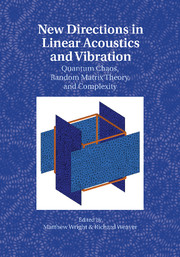Book contents
- Frontmatter
- Contents
- Foreword by Michael Berry
- Introduction
- 1 The Semiclassical Trace Formula
- 2 Wave Chaos for the Helmholtz Equation
- 3 The Unreasonable Effectiveness of Random Matrix Theory for the Vibrations and Acoustics of Complex Structures
- 4 Gaussian Random Wavefields and the Ergodic Mode Hypothesis
- 5 Short Periodic Orbit Theory of Eigenfunctions
- 6 Chaotic Wave Scattering
- 7 Transfer Operators Applied to Elastic Plate Vibrations
- 8 Mesoscopics in Acoustics
- 9 Diagrammatic Methods in Multiple Scattering
- 10 Time-Reversed Waves in Complex Media
- 11 Ocean Acoustics: A Novel Laboratory for Wave Chaos
- 12 Mesoscopic Seismic Waves
- 13 Random Matrices in Structural Acoustics
- 14 The Analysis of Random Built-Up Engineering Systems
- References
- Index
13 - Random Matrices in Structural Acoustics
Published online by Cambridge University Press: 05 October 2010
- Frontmatter
- Contents
- Foreword by Michael Berry
- Introduction
- 1 The Semiclassical Trace Formula
- 2 Wave Chaos for the Helmholtz Equation
- 3 The Unreasonable Effectiveness of Random Matrix Theory for the Vibrations and Acoustics of Complex Structures
- 4 Gaussian Random Wavefields and the Ergodic Mode Hypothesis
- 5 Short Periodic Orbit Theory of Eigenfunctions
- 6 Chaotic Wave Scattering
- 7 Transfer Operators Applied to Elastic Plate Vibrations
- 8 Mesoscopics in Acoustics
- 9 Diagrammatic Methods in Multiple Scattering
- 10 Time-Reversed Waves in Complex Media
- 11 Ocean Acoustics: A Novel Laboratory for Wave Chaos
- 12 Mesoscopic Seismic Waves
- 13 Random Matrices in Structural Acoustics
- 14 The Analysis of Random Built-Up Engineering Systems
- References
- Index
Summary
This chapter is devoted to the predictions of complex structural–acoustic systems in the low and medium frequencies for which computational structural–acoustic models are required. The presentation is limited to a bounded structure coupled with bounded internal acoustic cavities. In order to simplify the presentation, the acoustic coupling of the structure with an unbounded external acoustic fluid is not considered here but can be taken into account without any difficulties. For complex systems, the main problem induced by such predictions is due to the incapacity of computational models (and of any another approaches) to represent a real complex system even if the model used is very sophisticated (multiscale modeling, very large number of degrees of freedom used in the finite element model, etc.). This problem is induced by the presence of both the system parameter uncertainties and the model uncertainties in the computational model and by the variabilities of the real complex system with respect to the design system. The objectives of this chapter is to model the uncertainties in the structural–acoustic computational model by using the random matrix theory and also to present a methodology to perform an experimental identification of the stochastic model and to present an experimental validation.
The designed structural–acoustic system is the system conceived by the designers and analysts. A designed structural–acoustic system, made up of a structure coupled with an internal acoustic cavity, is defined by geometrical parameters, by the choice of materials, and by many other parameters.
Information
- Type
- Chapter
- Information
- New Directions in Linear Acoustics and VibrationQuantum Chaos, Random Matrix Theory and Complexity, pp. 206 - 230Publisher: Cambridge University PressPrint publication year: 2010
Accessibility standard: Unknown
Why this information is here
This section outlines the accessibility features of this content - including support for screen readers, full keyboard navigation and high-contrast display options. This may not be relevant for you.Accessibility Information
- 3
- Cited by
